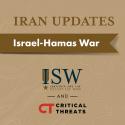Iran Update, December 27, 2023
Dec 27, 2023 - ISW Press
Iran and Iranian-backed Iraqi militias are driving an escalation cycle that combines military and political pressure to try to expel US forces from Iraq. Iranian-backed militia Harakat Hezbollah al Nujaba said on December 11 that expelling US forces requires political efforts from the government and military efforts from the militias. Iranian-backed attacks against US forces combine both military and political effects to drive US forces from Iraq, which is a long-held objective for Iran and its proxies. Iranian-backed militias—not the United States—are driving the escalation in Iraq by conducting attacks that risk killing US military personnel to trigger US self-defense airstrikes against the militias. These Iranian-backed groups then frame these self-defense airstrikes as a violation of Iraqi sovereignty to argue that the Iraqi government should expel the United States from Iraq. The United States is in Iraq at the invitation of Iraq’s government to defeat ISIS, meaning that Iranian-backed attacks on an Iraqi partner are themselves a violation of Iraqi sovereignty.










